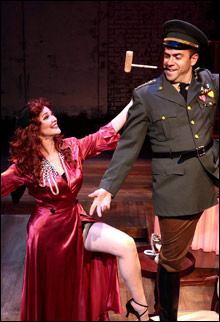
WHY CAN'T YOU BEHAVE? And why did they have to give "From This Moment On" to Lilli and her peacock of a fiancé? |
With its supreme Cole Porter score and its robustly entertaining book by Sam and Bella Spewack, the 1948 Kiss Me, Kate is surely one of the half-dozen best Broadway musicals. It's more fun than The Taming of the Shrew, which it simultaneously adapts and updates: the setting is the Baltimore tryout of a new musical of Shakespeare's comedy, and its stars are a one-time married couple whose combative relationship emulates that of Petruchio and Katharine. And on some level the show always works; it survived even Kathryn Grayson and the taming down of Porter's ribald lyrics in the 1953 MGM film version.Audiences seemed to be having a fine time at last Saturday's matinee of the current Lyric Stage mounting (which runs through October 10), despite the mediocre production. Spiro Veloudos has chosen to stage the version Kathleen Marshall brought to Broadway in the '90s, but he hasn't rethought it for the much smaller space. Marshall began with "Another Op'nin', Another Show," to introduce the backstage setting, and then used the overture to provide the characters with old-fashioned entrances like the performers in a Busby Berkeley movie musical. But there isn't enough area for the Lyric actors to inhabit to cover the music: they look uncomfortable, and the overture feels like filler. The choreography by Ilyse Robbins seems similarly hampered by the constricted space, though both the Lyric and SpeakEasy have proved that it's possible to stage musicals effectively here. I got the impression that Robbins had come up with an abundance of big ideas that she couldn't bring to fruition on this stage and was forced to scale them down; the dances feel as if they'd been hacked out of larger, uncompleted choreographic conceptions.
This Kiss Me, Kate is also physically clumsy. The movement from scene to scene isn't organic, and though you sympathize with the designers' efforts to make a virtue of economic necessity, what both Janie E. Howland (sets) and Rafael Jean (costumes) have come up with is unattractive. The costumes are especially ugly, and sometimes perplexing. The soldiers who show up in the second act wear two-toned uniforms, General Harrison Howell (Timothy John Smith) smokes a corncob pipe, and the hats on the two scene-stealing gangsters (Neil A. Casey and J.T. Turner) are incongruous: the actors look as if they'd stepped out of a Western. Even the lighting design by Scott Clyve has its oddity: a gobo effect meant to suggest stained glass for Kate and Petruchio's wedding celebration looks more like a Ferris wheel.

The cast members — led by Peter Davenport as Fred Graham/Petruchio, Amelia Broome as Lilli Vanessi/Katharine, Michele DeLuca as Lois Lane/Bianca, and R. Patrick Ryan as Bill Calhoun/Lucentio — appear to have been chosen more for their pipes than for their acting chops. Except for a few flattened high notes and a few verses where the singers seem to be fighting the off-stage orchestra — glitches that will likely be worked out in the course of the run — these and the other singers under Jonathan Goldberg's direction acquit themselves efficiently. But they don't bring much personality to the numbers. The only songs performed memorably are the two second-act crowd pleasers, "Brush Up Your Shakespeare" by Casey and Turner and "Always True to You (in My Fashion)" by DeLuca. The dialogue scenes lack verve and rhythm. This is particularly a problem in the exchanges between Fred and Lilli, which the Spewacks wrote to be played as banter but which Davenport and Broome read too emphatically, hammering most of the wit out of them.
Kiss Me, Kate is a long musical — nearly three hours — and at the Lyric it feels its length. But from beyond the grave Cole Porter keeps bailing the production out. There isn't a second-rate tune in the whole show, and that includes "From This Moment On," which Marshall interpolated from the Hollywood score. (Unfortunately she gave it to Lilli and Howell, Lilli's peacock of a fiancé, as an extraneous comic duet in the second act. In the movie it's the occasion for a pas de six featuring, among others, a dazzling young Bob Fosse.) When the show is over, you don't know which of these gems to hum first.